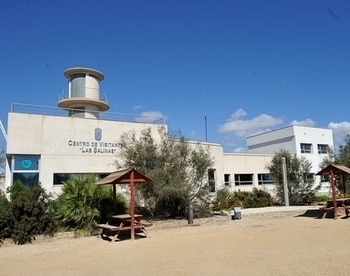- Region
- Águilas
- Alhama de Murcia
- Jumilla
- Lorca
- Los Alcázares
- Mazarrón
- San Javier
-
ALL AREAS & TOWNS
- AREAS
- SOUTH WEST
- MAR MENOR
- MURCIA CITY & CENTRAL
- NORTH & NORTH WEST
- TOWNS
- Abanilla
- Abarán
- Aguilas
- Alamillo
- Alcantarilla
- Aledo
- Alhama de Murcia
- Archena
- Balsicas
- Blanca
- Bolnuevo
- Bullas
- Cañadas del Romero
- Cabo de Palos
- Calasparra
- Camping Bolnuevo
- Campo De Ricote
- Camposol
- Canada De La Lena
- Caravaca de la Cruz
- Cartagena
- Cehegin
- Ceuti
- Cieza
- Condado de Alhama
- Corvera
- Costa Cálida
- Cuevas De Almanzora
- Cuevas de Reyllo
- El Carmoli
- El Mojon
- El Molino (Puerto Lumbreras)
- El Pareton / Cantareros
- El Raso
- El Valle Golf Resort
- Fortuna
- Fuente Alamo
- Hacienda del Alamo Golf Resort
- Hacienda Riquelme Golf Resort
- Isla Plana
- Islas Menores & Mar de Cristal
- Jumilla
- La Azohia
- La Charca
- La Manga Club
- La Manga del Mar Menor
- La Pinilla
- La Puebla
- La Torre
- La Torre Golf Resort
- La Unión
- Las Palas
- Las Ramblas
- Las Ramblas Golf
- Las Torres de Cotillas
- Leiva
- Librilla
- Lo Pagan
- Lo Santiago
- Lorca
- Lorquí
- Los Alcázares
- Los Balcones
- Los Belones
- Los Canovas
- Los Nietos
- Los Perez (Tallante)
- Los Urrutias
- Los Ventorrillos
- Mar De Cristal
- Mar Menor
- Mar Menor Golf Resort
- Mazarrón
- Mazarrón Country Club
- Molina de Segura
- Moratalla
- Mula
- Murcia City
- Murcia Property
- Pareton
- Peraleja Golf Resort
- Perin
- Pilar de la Horadada
- Pinar de Campoverde
- Pinoso
- Playa Honda
- Playa Honda / Playa Paraíso
- Pliego
- Portmán
- Pozo Estrecho
- Puerto de Mazarrón
- Puerto Lumbreras
- Puntas De Calnegre
- Region of Murcia
- Ricote
- Roda Golf Resort
- Roldan
- Roldan and Lo Ferro
- San Javier
- San Pedro del Pinatar
- Santiago de la Ribera
- Sierra Espuña
- Sucina
- Tallante
- Terrazas de la Torre Golf Resort
- Torre Pacheco
- Totana
- What's On Weekly Bulletin
- Yecla


- EDITIONS:
 Spanish News Today
Spanish News Today
 Alicante Today
Alicante Today
 Andalucia Today
Andalucia Today
article_detail
Virgen del Carmen, San Pedro del Pinatar
Fiestas of the Virgen del Carmen are held annually on the 16th July
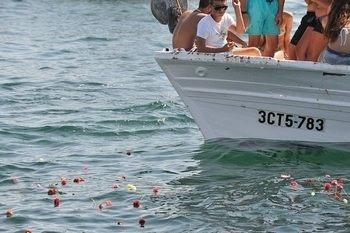
The celebrations of the Virgen del Carmen take place on the 16th July every year, and are one of the most important traditions in the Mar Menor, focusing on the Virgen del Carmen, protector of the fishing fleet, who is taken to sea in a Romería Marítima, a sea procession, from Lo Pagán in San Pedro del Pinatar.Although 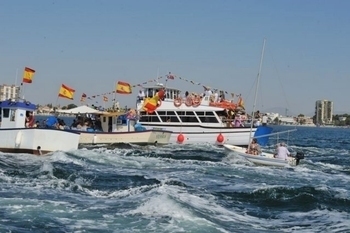 there are marine processions in several locations to celebrate the Virgen del Carmen, the parade at San Pedro del Pinatar is the most important.
there are marine processions in several locations to celebrate the Virgen del Carmen, the parade at San Pedro del Pinatar is the most important.
The Fiestas relating to this day were declared as being of tourist interest in 1965, and each year thousands of people pack the streets and dress their pleasure boats to be part of the event.
The day begins at 7am, when the municipal musical band parade through the streets of the municipality calling the faithful to participate, the parade terminating in the Plaza de la Constitución, where mass is celebrated in the Parroquía de San Pedro Apóstol at 8am.
At 9am, the Virgen leaves the Parroquía of San Pedro in Romería, heading towards the Mar Menor and Lo Pagán, arriving for 10am.
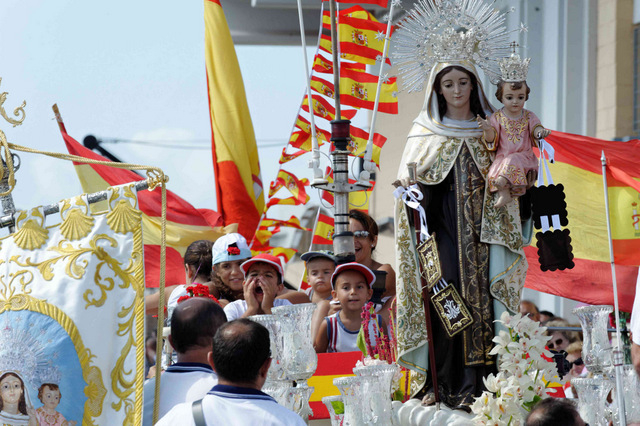 Prior to her arrival at Lo Pagán, boats of all shapes and sizes have been mooring up in preparation, dressed with bunting and sporting flags
Prior to her arrival at Lo Pagán, boats of all shapes and sizes have been mooring up in preparation, dressed with bunting and sporting flags
Upon her arrival, the Virgen is loaded onto a fishing boat and taken out to sea, accompanied by a multitude of fishing and pleasure boots, horns hooting to celebrate her presence, crammed full with people enjoying their participation in this event.
Once out at sea, carnations are thrown into the water to commemorate those lost at sea and all aboard the boats observe a minute´s silence, before the Virgen returns to the explanade of the fishing port, where mass is celebrated at 12 Midday.
Following this, the Virgen del Carmen is taken to the Iglesia del Carmen at Lo Pagán.
At 11.30pm, there is a large firework display in farewell to the Virgen, who is then returned in solemn procession to San Pedro del Pinatar.
At about one Oclock in the morning, she arrives back at the Parroquial church and an emotional Salve Marinera is sung to welcome her back, followed by a large burst of fireworks to close the celebrations.
History behind the devotion to the Virgen del Carmen.
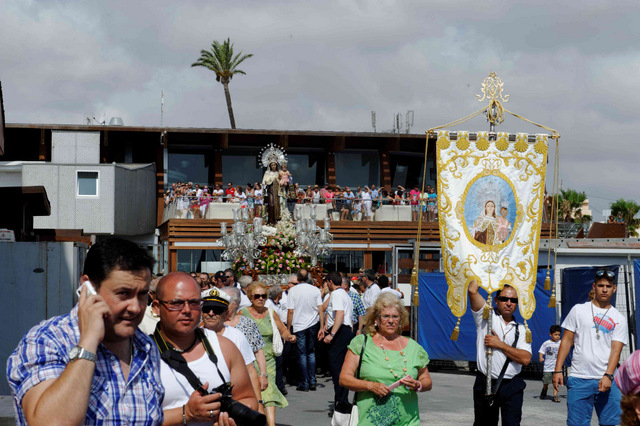 The history of devotion to the Virgen del Carmen goes way back in history, 300 years before Christ was even born, to Galilea, and to a mountain called the Carmelo, the Hebrew word for garden.
The history of devotion to the Virgen del Carmen goes way back in history, 300 years before Christ was even born, to Galilea, and to a mountain called the Carmelo, the Hebrew word for garden.
The story says that in 300 BC a great drought threatened the livelihood of all those living in the area, and the holy men living on the mountain, amongst them the Prophet Elias, joined with those praying for rain. Whilst praying on the mountain top he saw a vast white cloud which came from the sea and rose into the air, bringing the much longed for rain.
Elias interpreted this as being a sign of the coming of a saviour, who would be conceived from a virgin and would bring a rain of blessings. From then on, the community dedicated itself to praying for the mother of the redeemer, and for her arrival, the result of which was the emergence of the Carmelites, whose devotion was to our Lady of Carmen, the Virgen del Carmen.
The day of 16th July as being the day of the Virgen del Carmen is actually due to an Englishman, a man called Simon Stock who founded various monasteries dedicated to the cult of the Virgen del Carmen across Europe in the 13th century.
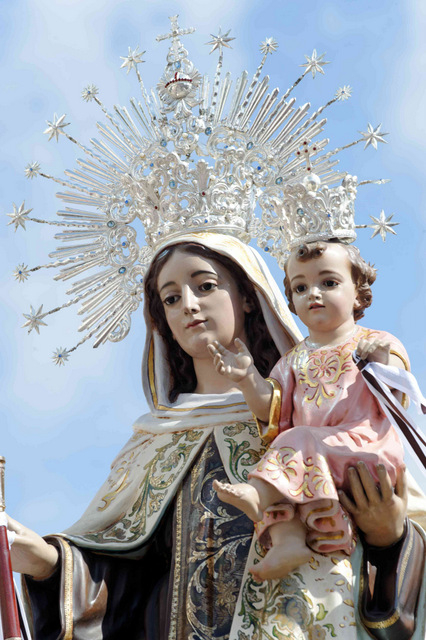 On the 16th July 1251, the Virgen is said to have appeared to him holding a scapular in her hands, saying the words: Let this be a sign and privilege for you and for all Carmelites: whoever dies, using the scapular will never suffer eternal fire.
On the 16th July 1251, the Virgen is said to have appeared to him holding a scapular in her hands, saying the words: Let this be a sign and privilege for you and for all Carmelites: whoever dies, using the scapular will never suffer eternal fire.
( A scapular for non Catholics is a piece of cloth worn by religious orders, having originated as an apron, but is also a devotional item consisting of two small pieces of cloth, or laminated paper joined by two longer pieces of cloth, normally bearing religious texts.
Both bring promises for those who wear them.
So that´s why her day is the 16th July.
By the Middle ages the Virgen del Carmen had become known as the "Estrella del Mar" the star of the sea, of particular significance for sailors who are guided by the stars of the sea. The Virgen became associated as the star who guides us through the difficult waters of life to safe port, the port being the love of Christ.
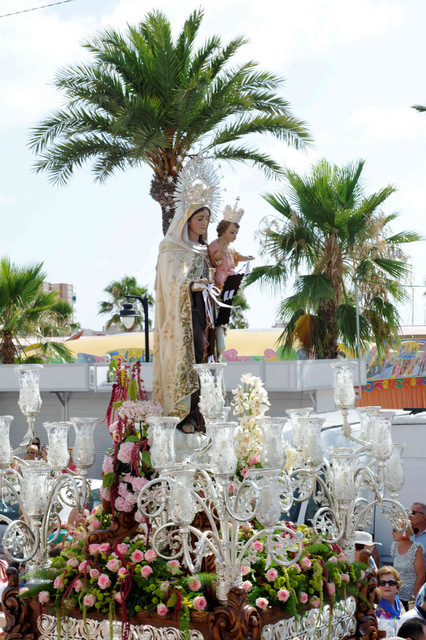 By the 18th century the cult of the Virgen del Carmen was widespread in Spain and towards the end of the 18th century, the Spanish Admiral Antonio Barceló Pont de la Terra ( 1716- 1797) decided to change the patronship of Spanish sailors from that of Saint Telmo for that of the Virgen del Carmen.
By the 18th century the cult of the Virgen del Carmen was widespread in Spain and towards the end of the 18th century, the Spanish Admiral Antonio Barceló Pont de la Terra ( 1716- 1797) decided to change the patronship of Spanish sailors from that of Saint Telmo for that of the Virgen del Carmen.
You´ll often find a "Barrio del Carmen" in Spanish cities, a district named in her honour, and it´s normal for there to be a celebration of some sort in any Barrio del Carmen on the 16th July.
Here in the region of Murcia, acts of homage to the Virgen del Carmen are known to have begun in 1792.
Images: Copyright Murcia Today
article_detail
Contact Murcia Today: Editorial 000 000 000 /
Office 000 000 000


